I'm trying to create a simple panel where a 2-dimensional ball is bouncing up and down. I can't get it to work because for some reason I can't call the repaint method more than once a second. The design is basically that there is an object that can be given "an impulse" with the method move(). Everytime the evaluatePosition method is called, the current position will be calculated through the time that has passed, the velocity and the acceleration. The code for the panel is:
public class Display extends JPanel {
private MovableObject object = new MovableObject(new Ellipse2D.Double(5,5,50,50));
private static final int DELAY = 1000;
public Display(){
object.move(50,50);
Timer timer = new Timer(DELAY, new ActionListener(){
@Override
public void actionPerformed(ActionEvent e){
object.evaluatePosition();
repaint();
}
});
timer.start();
}
}
@Override
public void paintComponent(Graphics g){
super.paintComponent(g);
Graphics2D g2 = (Graphics2D)g;
g.setRenderingHint(RenderingHints.KEY_ANTIALIASING, RenderingHints.VALUE_ANTIALIAS_ON);
g.drawOval((int)object.getPosition().getX(), (int)object.getPosition.getY()
(int)object.getShape().getWidth(), object.getShape().getHeight());
}
This code works for DELAY=1000 but not for DELAY=100 or DELAY=10 and so on. I read some example code here on SO but they all seem to me like what I already did. So why is my code not working?
EDIT (2016-01-30): Since it really seems to be a performance issue, here's the code for the MovableObject (I just thought it would be irrelevant and you will probably see why):
public class MovableObject {
// I would really like to use Shape instead of Ellipse2D so that
// objects of any shape can be created
private Ellipse2D.Double shape;
private Point position;
// Vector is my own class. I want to have some easy vector addition and
// multiplication and magnitude methods
private Vector velocity = new Vector(0, 0);
private Vector acceleration = new Vector(0, 0);
private Date lastEvaluation = new Date();
public MovableObject(Ellipse2D.Double objectShape){
shape = objectShape;
}
public void evaluatePosition(){
Date currentTime = new Date();
long deltaTInS = (currentTime.getTime()-lastEvaluation.getTime())/1000;
// s = s_0 + v*t + 0.5*a*t^2
position = new Point((int)position.getX()+ (int)(velocity.getX()*deltaTInS) + (int)(0.5*acceleration.getX()*deltaTInS*deltaTInS),
(int)position.getY()+ (int)(velocity.getY()*deltaTInS) + (int)(0.5*acceleration.getY()*deltaTInS*deltaTInS));
lastEvaluation = currentTime;
}
}
public void move(Vector vector){
velocity = velocity.add(vector);
evaluatePosition();
}
public Point getPosition(){
return position;
}
public Ellipse2D.Double getShape(){
return shape;
}
My move method does not change position but velocity. Please notice that I just changed the shape Object from Shape to Ellipse2D for testing if my code has a performance issue because of the additional code. So if you think this is more complex than it needs to be: I actually want to add some complexity so that the MovableObject can have the shape of any subclass of shape. I've seen a lot of code that seemed more complex to me and rendered fast. So I'd like to know what's wrong with this (besides the fact that it's a bit too complex for just rendering an ellipse).
